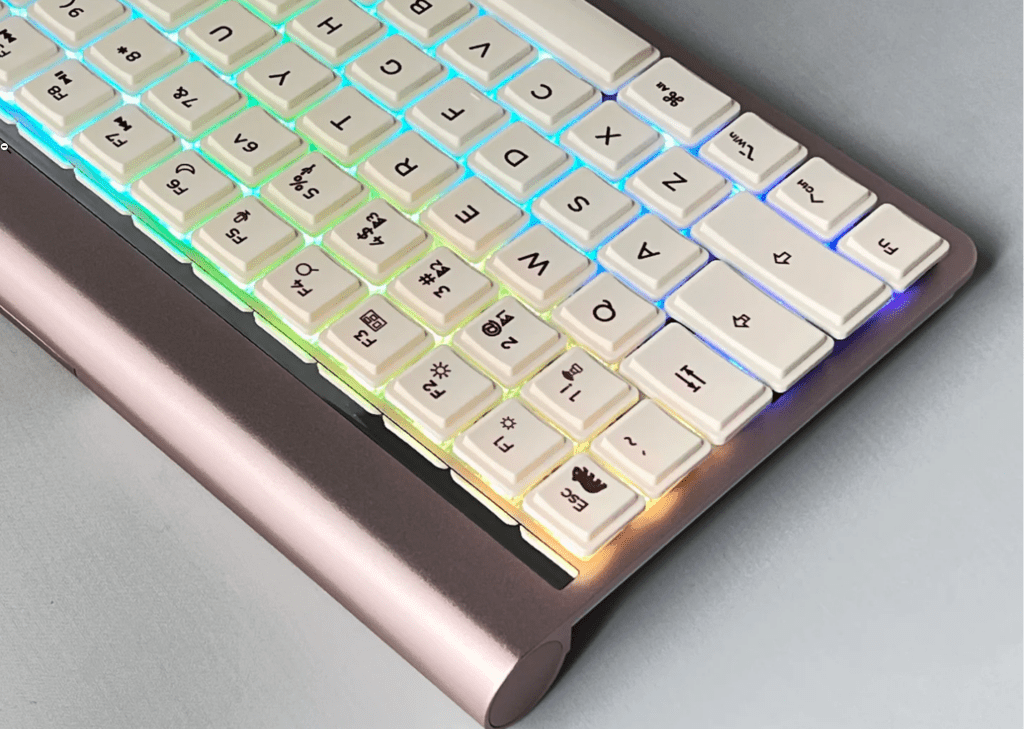I make a living typing, so the quality and comfort of my keyboard is crucial. I recently gave up my tried and true Logitech K800 for a couple of months and switched to using the Coleus keyboard from Wombat.
“How did that work out?” you might ask. Well, here is my review of the device.
Form: Striking Design and Quality Build
The Wombat Coleus mechanical keyboard enters the scene with an intriguing blend of form and function. Its physical design is a head-turner, featuring a sleek, minimalist layout. With a compact 75% layout, it strikes a balance between a compact form factor and functional key placement. The keyboard’s aluminum top plate gives it a premium, solid feel that is immediately noticeable upon unboxing.
The Coleus comes with a detachable USB-C cable, which adds to its convenience and portability. This detachable feature is a thoughtful addition, allowing users to easily swap out cables or carry them without worrying about damage.
In terms of keycaps, the Coleus keyboard offers a standard, 84-key US keyboard layout with hot-swappable key shafts. You can easily swap out the keycaps for a customized look and feel. The keycaps themselves are made of double-shot ABS plastic, ensuring durability and longevity.
One aspect that may divide users is the absence of dedicated function keys and the compact layout. While this is a matter of personal preference, it’s worth noting that the Coleus is designed to appeal to those who prefer a clean and compact layout without the bulk of a full-sized keyboard.
Function: Impressive Features and User-Friendly Operation
Moving on to functionality, the Coleus keyboard boasts several key features that set it apart in the mechanical keyboard market.
Switch Options: The Coleus is available with a choice of key switches—Gateron low-profile switches in LP Linear Red or LP Tactile Brown. This variety allows users to select switches that match their typing preferences, whether they prefer tactile, clicky, or linear switches. In my experience, the switches on the review unit offered a satisfying typing experience with a noticeable actuation point.
LED Customization: The keyboard’s RGB LED backlighting is a standout feature. The LEDs are bright and vibrant, and the keyboard allows for extensive customization. You can program and customize the lighting effects and colors to create a unique and visually appealing setup. However, as mentioned in the feedback, there is a learning curve involved in mastering the LED programming. Once you get the hang of it, though, the possibilities are nearly limitless.
Bluetooth Connectivity: The Coleus keyboard supports Bluetooth connectivity, which is a significant convenience factor for users who prefer a wireless setup. Pairing the keyboard with devices is straightforward, and it maintains a stable connection without noticeable lag. The option to switch between wired and wireless modes is a practical touch, catering to various usage scenarios.
Battery Life: While not an extensive battery life, the Coleus keyboard’s 1000mAh LiPO rechargeable battery pack offers decent longevity. It can last several days on a single charge, depending on usage patterns. Charging is quick and hassle-free via the USB-C cable.
Experience: Real-World Feedback and User Perspective
Now, let’s dive into the real-world experience of using the Wombat Coleus keyboard, incorporating the provided feedback.
Coleus Keyboard Pros:
- Satisfying Clicking Sounds: One of the immediate highlights of the Coleus keyboard is the auditory feedback it provides. Typing on it delivers a delightful clicky sound that can be music to the ears of mechanical keyboard enthusiasts. The feedback is both tactile and audible, enhancing the overall typing experience.
- Ease of LED Customization (With a Learning Curve): As previously mentioned, LED customization is a double-edged sword. Once you figure it out, the possibilities are endless, allowing you to create a visual masterpiece with your keyboard. However, there is a learning curve involved, and beginners might find it initially challenging to harness the full potential of the lighting customization.
- Responsiveness and Bluetooth Connectivity: The Coleus keyboard lives up to its promise of responsiveness. The keys strike a balance between being responsive and not overly sensitive, ensuring comfortable typing. Bluetooth connectivity is a boon for those who want a clutter-free workspace. Pairing is quick and reliable, making it suitable for both work and gaming scenarios. It can also connect via Wombat’s proprietary wireless transmission protocol (REX 2.0) over the 2.4GHz spectrum.
Coleus Keyboard Cons:
- Power Management Challenges: A notable downside is the slightly confusing power management. Users might struggle initially with turning the keyboard on and off. This inconvenience could be mitigated with clearer instructions or a more intuitive power switch placement.
- Learning Curve for LED Programming: While LED customization is a major selling point, it does come with a learning curve. Beginners may find it challenging to navigate the software and create their desired lighting effects. A more user-friendly interface or detailed tutorials could help alleviate this issue.
- Price Consideration: One of the aspects that require careful consideration is the price point of the Coleus keyboard. At nearly $150, it positions itself as a premium mechanical keyboard. Whether this price is justified largely depends on individual preferences and priorities.
The Verdict: The Wombat Coleus Keyboard – A Unique Blend of Style and Function
For those who prioritize aesthetics, a satisfying typing experience, and wireless convenience, the Coleus can be a worthwhile investment. However, for budget-conscious consumers, the price might be a significant hurdle to overcome, especially when there are more affordable mechanical keyboard options on the market.
The Wombat Coleus mechanical keyboard offers a distinctive combination of form and function. Its sleek design, customizable LED lighting, and wireless connectivity make it an attractive option for those seeking a premium keyboard experience. However, it’s important to acknowledge the learning curve associated with LED programming and the initial challenges with power management.
Ultimately, the Coleus keyboard caters to a specific niche of users who prioritize aesthetics and are willing to invest in a premium typing and gaming experience. While the price may be a deterrent for some, those who value the features it offers may find it to be a worthy addition to their setup. It’s a keyboard that stands out not only for its visual appeal but also for its performance and flexibility.
In the end, though—I did switch back to my Logitech K800. I am not suggesting it is the best keyboard by any stretch. I don’t think it is “better” than the Coleus, per se. I think keyboard preference is largely subjective, though, and I do just fine on the keyboard I have been using for years, so I am not interested in making a switch right now.
Besides, I use the number pad on a relatively frequent basis, so the Coleus is not ideal. However, its compact size means that I can carry it in my computer bag for use on the go.
- Why Data Security Is the Real AI Risk - June 30, 2025
- Why Being Bold Matters in Cybersecurity—and Branding - June 3, 2025
- Gear Tested and Approved: My Top Picks for Dads and Grads This Season - May 28, 2025



